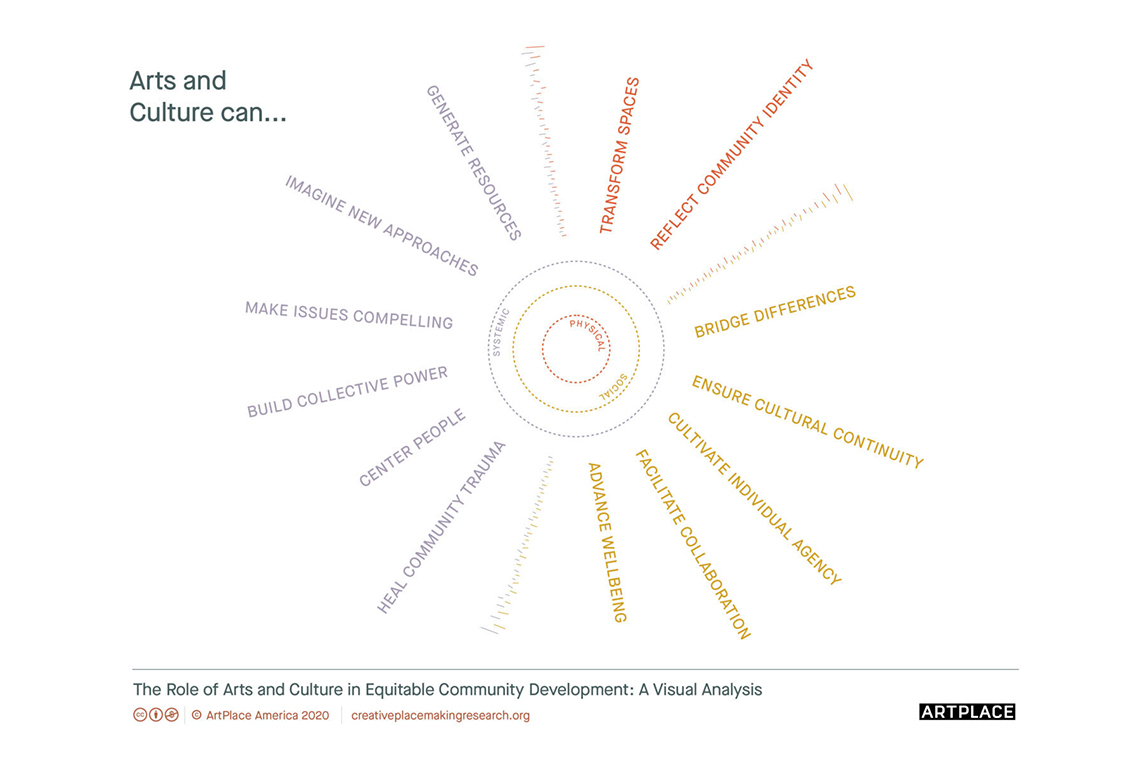
For those who have been closely following ArtPlace’s cross-sector initiatives, it’s thrilling to report that - as of last week - we have released research findings in all ten sectors of ArtPlace’s Community Development Matrix. We are indebted to all of the individuals and organizations who partnered with ArtPlace to conduct research and author the field scans, as well as the countless artists, community leaders, organizers, educators, funders, and policymakers who participated in ArtPlace’s research as either interviewees or working group participants over the last six years. Our work is based upon the insights and lived experience of hundreds of visionary individuals and institutions leading creative placemaking work across the United States.
Over the past few months, we have been quietly laying the foundation for one final resource that we are delighted to share today. The Role of Arts and Culture in Equitable Community Development: A Visual Analysis is a comprehensive analysis that cuts across all ten sectors, presented through an interactive infographic developed in collaboration with Studio MESH.
Throughout our research we’ve seen that creative placemaking best practices are comprehensive, touching on not one or two sectors but inhabiting the holistic intersection of them all. Key themes emerged across all ten sectors as well; the arts’ ability to reflect community identity, for example, showed up as anti-displacement work in the housing sector, and as part of welcoming initiatives in the immigration sector.
Arts and culture of course shapes our lives and impacts society in countless ways that are outside the scope of this research, but this new resource highlights thirteen ways that arts and culture can support equitable community development. Arts and culture can:
- Transform Spaces
- Reflect Community Identity
- Bridge Differences
- Ensure Cultural Continuity
- Cultivate Individual Agency
- Facilitate Collaboration
- Advance Wellbeing
- Heal Community Trauma
- Build Collective Power
- Center People
- Make Issues Compelling
- Imagine New Approaches
- Generate Resources
We share this analysis with both excitement and humility. For over six years we have been immersed in cross-sector thinking, listening for patterns and ideas that transcend any one sector. It has been a privilege to bring the sector-specific findings, at long last, into a comprehensive whole, and we hope it helps to further cement an understanding of artists as allies for equitable community development.
Yet, we hesitate to frame this analysis as any sort of conclusion. As ArtPlace closes its ten year chapter, we leave this resource behind as a provocation for arts and community development research, practice, and policy moving forward. We have invited responses from colleagues across the field of creative placemaking throughout 2021, and we are eager for others to conduct their own analyses with the data provided. Ultimately we hope that this can be a useful resource for those doing the critical work of building more creative and just futures in our communities, and we look forward to the continued evolution of these ideas in the coming years.
Visit www.creativeplacemakingresearch.org to access this analysis through an interactive infographic, download the data from all ten sectors, and read responses to this body of work from artists, educators, organizers, researchers, and more.





